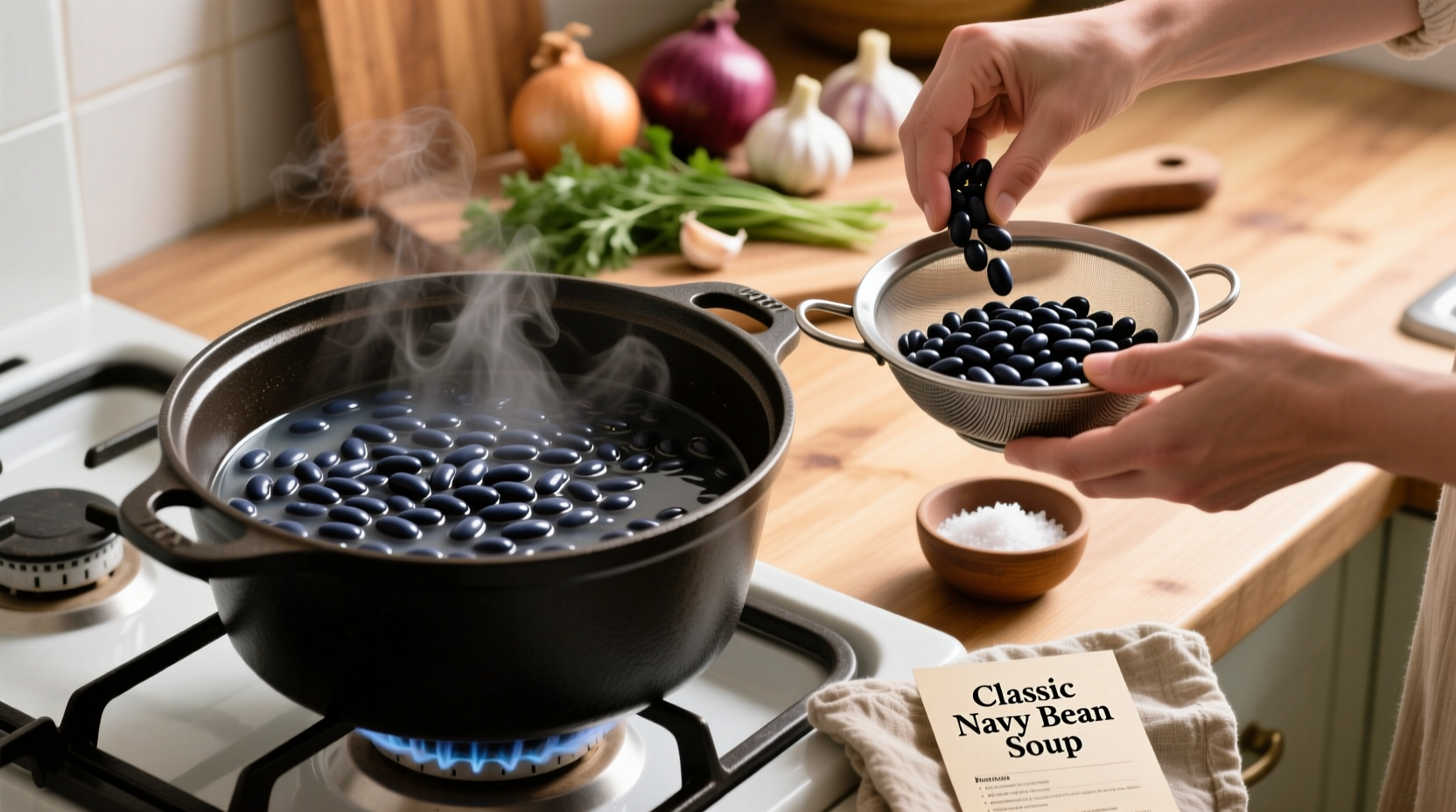Perfectly cooked navy beans require soaking for 8-12 hours (or quick-soaking for 1 hour), then simmering for 60-90 minutes until tender. Always discard soaking water, use fresh water for cooking, and avoid adding acidic ingredients until beans are fully tender to prevent hardening.
Discover the foolproof method to transform dried navy beans into creamy, flavorful staples for soups, salads, and side dishes. Whether you're meal prepping or making classic Boston baked beans, this guide delivers restaurant-quality results every time—no more chalky, undercooked beans or wasted hours guessing cooking times.
Why Navy Beans Deserve Your Attention
Navy beans (Phaseolus vulgaris) are nutritional powerhouses packed with 15g protein and 19g fiber per cooked cup. Their mild flavor and creamy texture make them ideal for everything from traditional New England clam chowder to modern plant-based burgers. Unlike canned alternatives, cooking from dried gives you complete control over sodium content and texture.
Preparation: Two Soaking Methods That Actually Work
Proper preparation prevents digestive discomfort and ensures even cooking. Never skip this step—under-soaked beans cook unevenly and may remain hard in the center.
Traditional Overnight Soak
- Sort 1 pound beans, removing debris
- Rinse thoroughly under cold water
- Cover with 3 inches of cold water in a large bowl
- Soak at room temperature for 8-12 hours
- Discard soaking water (reduces oligosaccharides causing gas)
Quick Hot Soak Method
- Place sorted beans in large pot
- Cover with 3 inches water, bring to rapid boil
- Boil vigorously for 2-3 minutes
- Remove from heat, cover, and soak 1-2 hours
- Drain and rinse before cooking
| Soaking Method | Time Required | Best For |
|---|---|---|
| Traditional Overnight | 8-12 hours | Weekend cooking, optimal texture |
| Quick Hot Soak | 1.5-2 hours | Weeknight meals, time-sensitive cooking |
According to the National Center for Home Food Preservation, discarding soaking water reduces flatulence-causing compounds by up to 30% compared to cooking without soaking. Their research confirms both methods effectively rehydrate beans when followed correctly.
Cooking Methods: Choose Your Perfect Technique
Stovetop Simmering (Most Control)
- Place soaked beans in large pot
- Cover with 2 inches fresh water or broth
- Add aromatics (onion, garlic, bay leaf)
- Bring to gentle boil, then reduce to simmer
- Cover partially, cook 60-90 minutes
- Check tenderness at 60 minutes
- Add salt only after beans soften
The FDA Food Code specifies beans must reach 212°F (100°C) for sufficient time to destroy naturally occurring lectins. Simmering for the full duration ensures food safety while developing optimal texture.
Electric Pressure Cooker (Fastest Results)
- Add soaked beans to pot
- Cover with 1.5 inches liquid
- Include aromatics but no salt
- Seal lid, set to high pressure
- Cook 25 minutes with natural release
- Add salt after cooking completes
Slow Cooker Method (Hands-Off Approach)
- Use pre-soaked beans only
- Cover with 2 inches liquid
- Add aromatics, no salt initially
- Cook on LOW 6-8 hours
- Check tenderness at 6 hours
- Add salt during last 30 minutes
Troubleshooting Common Navy Bean Problems
Hard Beans After Cooking
Causes: Old beans, hard water, or premature salt addition. Fix: Extend cooking time by 15-20 minutes. If persistent, add 1/4 teaspoon baking soda to cooking water (use sparingly as it can cause mushiness).
Excessive Foaming
Skim foam during first 10 minutes of cooking. This removes saponins that cause digestive discomfort. A wooden spoon placed across the pot helps prevent boil-overs.
Uneven Texture
Indicates inconsistent soaking. Always sort beans by size before soaking—larger beans need slightly longer soaking. The University of Minnesota Extension confirms size variation affects hydration rates, recommending sorting for professional results.
Flavor Variations Worth Trying
Classic Herb-Infused Beans
Add 2 sprigs fresh thyme, 1 bay leaf, and 3 garlic cloves during last 30 minutes of cooking. Finish with 2 tablespoons apple cider vinegar after cooking.
Smoky Ham Hock Version
Cook with 1 smoked ham hock during simmering. Remove hock after 45 minutes, shred meat, and return to pot. Perfect for Boston baked beans.
Vegan Mediterranean Style
Sauté onions and celery before adding beans. Stir in 1 teaspoon rosemary and 2 tablespoons lemon zest after cooking. Toss with olive oil and fresh parsley.
Storage and Usage Tips
Cool cooked beans within 2 hours. Store in cooking liquid in airtight containers:
- Refrigerator: Up to 5 days
- Freezer: Up to 6 months (portion in 1.5 cup servings)
Freeze flat in quart bags for quick defrosting. Always label with date and cooking method. For best texture, thaw overnight in refrigerator before reheating.
Use cooked navy beans in:
- White bean soup with escarole
- Salads instead of chickpeas
- Plant-based burger patties
- Thickening agent for sauces
Frequently Asked Questions
Can I cook navy beans without soaking?
Technically yes, but unsoaked beans require 2-3 hours cooking time and often have uneven texture. The FDA recommends soaking to reduce cooking time and improve digestibility.
Why shouldn't I add salt early?
Salt hardens bean skins during initial cooking. Add after beans soften (about 60 minutes) for optimal texture. Acidic ingredients like tomatoes should also wait until beans are tender.
How do I prevent gas from beans?
Discard soaking water, use the quick soak method, and add kombu seaweed during cooking. The University of Michigan Health System notes these methods reduce oligosaccharides by up to 60%.











 浙公网安备
33010002000092号
浙公网安备
33010002000092号 浙B2-20120091-4
浙B2-20120091-4